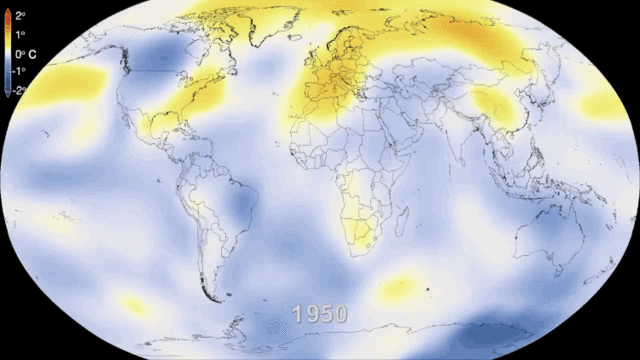Ozone, aerosols more culpable for climate change than carbon dioxide
Animation: NASA, via Wikimedia Commons
Texas A&M University researchers have found evidence supporting higher rates of climate change and more warming over the coming century, and their work could help end the debate over how much warming the Earth will experience in the future.
Andrew Dessler, professor of atmospheric sciences, and graduate student John Kummer have had their work published in Geophysical Research Letters, a publication of the American Geophysical Union. The project was funded by NASA.
The Texas A&M researchers determined that previous calculations of the Earth’s climate sensitivity have neglected an important factor. (The climate sensitivity is the warming that would occur if atmospheric carbon dioxide is doubled.)
“Over the past few years, a debate has raged in the scientific community over climate sensitivity,” Dessler explains. “Many researchers found that the 20th-century warming suggested a lower climate sensitivity of about 4 degrees F, while climate models and the paleoclimate record suggested a higher climate sensitivity of 6 degrees F.
“This difference may not sound like much,” said John Kummer, lead author on the study, “but it could have a profound effect on the impacts of climate change, such as heat waves, drought, and sea level rise.”
Kummer and Dessler calculated climate sensitivity based on the 20th-century warming, but with one key difference. “Previous estimates have assumed that all human emissions are equally effective at altering the climate,” Kummer said.
“However, greenhouse gases like carbon dioxide are well mixed in the atmosphere — this means that, no matter where you go, the amount of carbon dioxide is about the same.
“Ozone and aerosols, on the other hand, have short atmospheric lifetimes, so they are mainly found near where they are emitted. This means that the heating from these constituents are highly localized. Recent studies using climate models have suggested that this highly localized forcing is more effective at changing the climate.”
Dessler added, “What we did was to take the 20th-century observational record and calculate the climate sensitivity under the assumption that ozone and aerosols were about one-third more effective at warming the climate than well mixed greenhouse gases like carbon dioxide. We found that this yielded a climate sensitivity of 6 degrees F, in good agreement with other estimates of climate sensitivity.”
Dessler is confident that the new methods of calculation are an advance over previous calculations.
“We can now resolve the dispute over these different estimates of climate sensitivity,” he notes. “As the evidence for a large climate sensitivity accumulates and the evidence that it is low evaporates, our society needs to accept the science and begin thinking about what to do about it.”
Media contact: Keith Randall, News & Information Services, at (979) 845-4644 or Andrew Dessler at (979) 862-1427
#TAMUresearch


